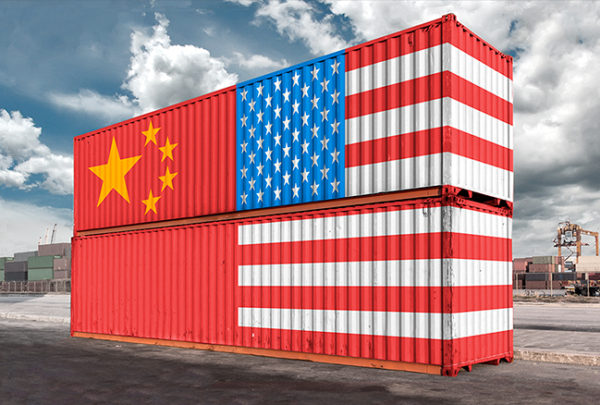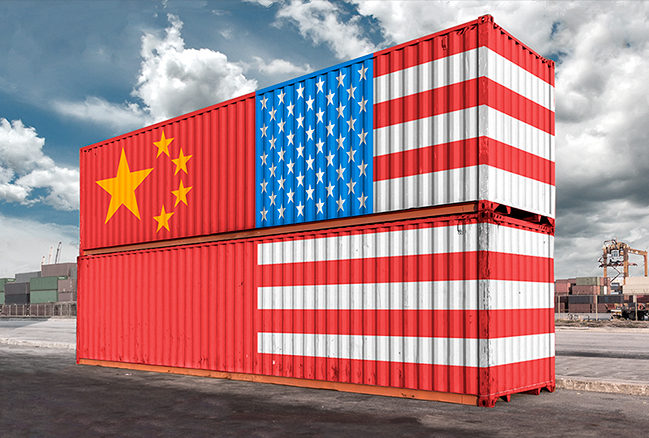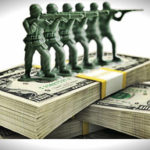
Image Credit: CNN Money
The battle between Donald Trump and the current policy on free trade continues to rage on even now that Trump has become the president-elect. Being Trump’s signature position, he ran on enforcing trade deals and cracking down on foreign trade cheating (i.e. theft of business secrets, buying foreign currency to influence the exchange rate to keep prices of goods low). To Trump’s critics, his vow to impose duties (taxes on goods crossing international borders), tariffs (tax used to protect domestic economy), and other trade fairness measures contrasts the American ideal of free enterprise. However, the trade gap — the amount the US spends on foreign goods subtracted by the amount that it earns by selling goods to other countries –continues to grow. In October alone, the gap grew 18% to $42.6 billion, an increase of $6.4 billion.[2]. Trump hopes that the tariffs and duties he offers in replacing our current free trade model will protect and incentivize American workers and goods over their foreign counterparts and therefore keep money flowing back and forth between American consumers and American producers. Now while the trade gap’s impact is hard to see on a day-to-day basis, trade deficits are just like other debts in many respects. They must be repaid, and they harm the economy in many different ways.
- The continued growth of our trade deficit through the last couple of decades has killed off millions of high paying U.S. manufacturing jobs. Between 1979 and 1994, trade eliminated 2.4 million jobs in the U.S. [3]
- Trade deficits have also had a depressing effect on wages, in several ways. Not only by eliminating good jobs but also by pushing down the prices of domestic products and by decreasing labor’s bargaining power with multinational firms.[4]
- Deficits erode on our long-term trade competitiveness. When the U.S. dollar and our trade deficit soared in the early 1980s, many domestic firms and industries in sectors such as steel and semiconductors were decimated.[5]
- Based on the current trends, we no longer produce what we need for everyday consumption. What would happen to our delicate balance if these other countries decided to reduce or stop lending at the current rate? How would we supply any major military action or global disruption to the trade market in the future?
And herein lies the conflict of the issue – is it a threat to free enterprise to impose tariffs and duties to balance our trade deficit? Does America continue down it’s current policy and hope that the free market in America solves the trade gap or should lawmakers take action in the free market to decrease the growing imbalance in trade?
Due to the issues trade deficits create, politicians need to decide how to best approach the issue. There are many proposed ideas of fixing the ever-growing trade issues.
- Emergency Tariff Solution: Washington journalist William Greider proposes a tariff of 10 or 15 percent to reduce the U.S. trade deficit. If Congress were to implement that idea, American imports would probably decline as intended.[6]
- Currency Manipulation: Another proposition is to put downward pressure on the value of its own currency by creating an excess amount of that currency and using the excess to purchase foreign currencies. This would increase exports and decrease imports, thus reducing a trade deficit.[7] However, fewer imports would mean fewer dollars streaming into the international market pushing the currency value up – meaning prices for American goods go up.
- Trade Deficit Plan: Another way to cut the trade deficit is for the government to borrow less so to free up more funds for domestic investment, reducing the demand for foreign capital. This is known as the “twin deficits.” It’s a phenomenon that came from the 1980’s, when huge federal budget deficits claimed a greater amount of national savings requiring more investment from abroad. The inflow of “foreign capital prompted by the budget deficit allowed Americans to buy even more goods and services than they sold in the international marketplace.”[8] As the federal budget deficit declined in the late 1980’s, so too did America’s trade deficit.
Now, President-elect Trump has clearly been influenced by the protectionist traditions the Republican Party has lived by since its creation. According to Robert Lighthizer, a deputy U.S. trade representative during the Reagan administration, “The Republican Party has been the party of building domestic industry by using trade policy to promote U.S. exports and fend off unfairly traded imports. American conservatives have had that view for even longer. Every Republican president starting with Lincoln – and for almost 100 years thereafter – generally supported tariffs, while Democrats tended to promote free trade.”[9] Our trade deficit with China today massively dwarfs any trade imbalances in the past. Even so, Reagan reduced any trade deficit with Japan and saved the Harley-Davidson by imposing a 45% tariff on Japanese motorcycles, an act that was greatly criticized by the “free traders” of the day.[10] So based on historical precedents and the current state of America’s trade deficit, taking on more protectionist policies will best serve America and its citizens. After all, isn’t that what U.S. leaders supposed to do – take care of American citizens first?
For More information and ways to get involved, go to the Economic Policy Institute website (epi.org). The organization looks to provide ways to strengthen workers’ right and raise their wages.
REFERENCES AND FOOTNOTES
[1] Weiser, C. (2016, September 16). In rebuke to Donald Trump, John Kasich to join Barack Obama in free trade push. USA Today [Mclean, VA]. Retrieved from http://www.usatoday.com/story/news/politics/blogs/2016/09/15/john-kasich-push-free-trade-white-house/90444732/
[2] Staff Writer. (2016, December 6). US exports to China rise; total trade deficit widens in October. Retrieved from http://www.energy-daily.com/reports/US_exports_to_China_rise_total_trade_deficit_widens_in_October_999.htm
[3] Scott, Robert E.,Thea Lee and John Schmitt. 1997. “Trading Away Good Jobs: An Examination of Employment and Wages in the U.S., 1979-94,” Briefing paper. Washington, D.C.: Economic Policy Institute. October.
[4] Scott, Robert E. and Jesse Rothstein. 1998. American Jobs and the Asian Crisis. Washington, D.C. Economic Policy Institute. Issues Brief. January.
[5] Morici, Peter. 1997. “The Trade Deficit: Where Does it Come From and What Does it Do?” Washington, D.C.: The Economic Strategy Institute. October. P. 20.
[6] Greider, W. (2005, March 24). Elite Protectionists | The Nation. Retrieved from https://www.thenation.com/article/elite-protectionists/
[7] Griswold, D. (1998, July 22). America’s Misunderstood Trade Deficit | Cato Institute. Retrieved from https://www.cato.org/publications/congressional-testimony/americas-misunderstood-trade-deficit
[8] Ibid.
[9] Lighthizer, R. E. (2011, May 9). LIGHTHIZER: Donald Trump is no liberal on trade – Washington Times. Retrieved from http://www.washingtontimes.com/news/2011/may/9/donald-trump-is-no-liberal-on-trade/
[10] Farnsworth, C. H. (1983, April 2). U.S. RAISES TARIFF FOR MOTORCYCLES – NYTimes.com. Retrieved from http://www.nytimes.com/1983/04/02/business/us-raises-tariff-for-motorcycles.html




